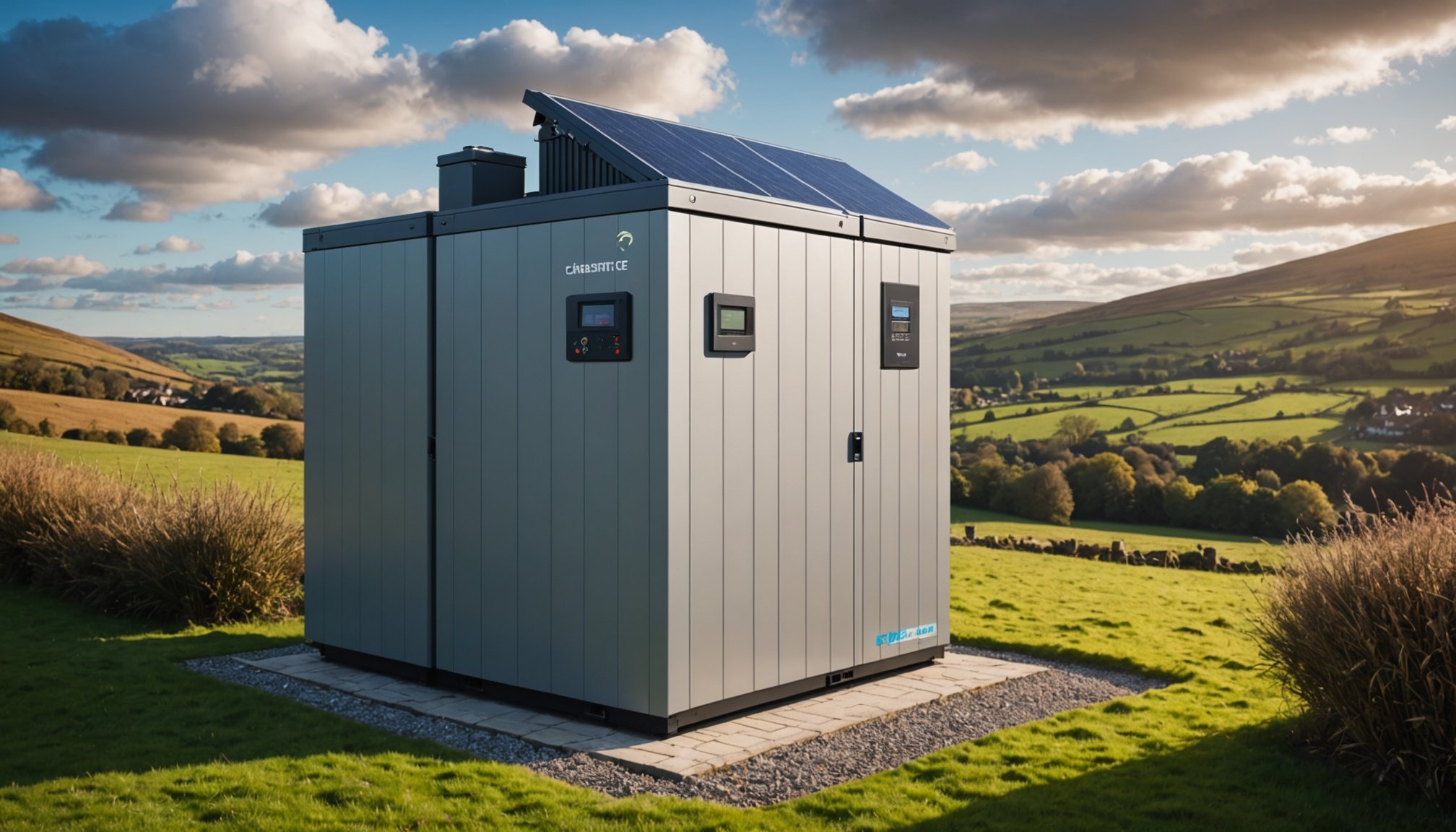Overview of Home Battery Storage Technologies
Home battery storage systems have revolutionized how households manage energy. At their core, these systems store excess electricity generated from renewable technologies like solar panels, enabling homeowners to use this stored energy during peak hours when energy costs are typically higher. This approach not only maximizes energy efficiency but also reduces reliance on the grid.
Several key technologies are pivotal in these systems. Lithium-ion batteries dominate the market due to their high efficiency and long lifespan, making them suitable for many household energy needs. Conversely, lead-acid batteries are cost-effective but typically have shorter lifespans and lower energy densities. Flow batteries, though less common, offer scalability and long-duration energy storage—ideal for larger installations.
Also read : Unlocking the Secret to Launching a Premier Coffee Haven in Rural UK
The significance of home battery storage extends beyond individual household benefits. On a broader scale, these systems enhance overall energy efficiency and stability. By effectively integrating with renewable technologies, battery storage mitigates intermittency issues commonly associated with renewable energy sources like solar and wind. This synchronization not only facilitates energy independence but also showcases a sustainable path towards reducing carbon footprints and promoting cleaner energy consumption.
Comparison of Different Battery Storage Systems
When evaluating battery storage solutions, it’s crucial to compare various battery types: lithium-ion, lead-acid, and flow batteries. Each has distinct performance characteristics impacting their suitability for different energy systems.
Have you seen this : Unlocking the Secret to Launching a Premier Coffee Haven in Rural UK
Lithium-ion Batteries
Lithium-ion batteries are famed for high energy density and efficiency, offering increased storage capacity and rapid charging cycles. Though initial costs are higher, their longer lifespan reduces long-term expenses. These attributes make them ideal for households requiring reliable, consistent energy.
Lead-acid Batteries
Lead-acid batteries, on the other hand, offer a more economical option with lower upfront costs. Despite a shorter lifespan and lower efficiency, they can be effective for smaller installations with modest energy demands. They are commonly chosen for backup applications and short-term energy storage needs.
Flow Batteries
Flow batteries stand out for their capability to handle large-scale storage requirements. They offer exceptional scalability, are suitable for extensive energy systems, and have a unique recharging process allowing long-duration energy release. Their versatile nature makes them a strong contender in innovative large installations.
Understanding the cost considerations and specific energy needs ensures selecting the most appropriate type to optimize household energy performance.
Benefits of Home Battery Storage
Home battery storage offers numerous advantages, emphasising energy independence, cost savings, and environmental impact. By harnessing stored energy, households reduce reliance on the grid, achieving greater energy independence. This autonomy means less susceptibility to utility rate hikes and power outages.
One compelling benefit is the potential for cost savings through time-of-use energy tariffs. By drawing on stored energy during peak pricing periods, homeowners can mitigate high electricity costs, maximising the economic efficiency of their energy usage. Additionally, battery storage can lead to lowered monthly utility bills, positively impacting household finances over time.
From an environmental perspective, integrating battery storage with renewable technologies bolsters the overall positive impact. These systems enable users to store and utilise solar or wind energy, significantly reducing reliance on fossil fuels. As homes optimise the use of self-generated renewable energy, they collectively contribute to reducing their carbon footprint and promoting sustainable practices.
In sum, the investment in home battery storage is an impactful step towards a more sustainable and energy-efficient future, providing personal and ecological benefits.
Integration with Renewable Energy Sources
Integrating home battery storage with renewable energy sources, such as solar and wind, dramatically enhances the efficiency and utilization of these technologies. How does this work? By storing excess electricity generated during periods of high production, like sunny or windy days, these batteries allow households to shift energy use to times when renewable generation is low. This ensures a more consistent, reliable energy supply around the clock.
However, challenges arise in ensuring seamless integration. Compatibility between battery systems and renewable setups is crucial. For instance, solar integration often requires inverters calibrated to manage energy flow between panels, batteries, and household circuits. Similarly, wind energy systems must balance fluctuating production levels with battery capacity to prevent overloading.
Maximizing renewable energy with home storage demands strategic planning. Using energy monitoring tools helps in identifying when to store or release energy based on consumption patterns and weather forecasts. By addressing integration challenges through technology and planning, homeowners can significantly increase energy efficiency, reduce grid dependency, and capitalize on sustainable energy opportunities, propelling the move towards a cleaner energy future.
Strategies for Optimal Use of Battery Storage
Home Battery Storage can greatly enhance peak energy performance when used effectively. The key is to optimise charging and discharging cycles and employ efficient usage guidelines.
Best Practices for Charging and Discharging
Effective charging and discharging of batteries contribute significantly to energy efficiency. It is advisable to charge home battery storage during off-peak hours when electricity rates are lower. This not only saves money but ensures batteries are filled when demand is low. On the other hand, discharging should occur during peak times, providing energy when grid rates are high.
Monitoring Energy Consumption
Implementing consistent energy consumption monitoring helps identify energy usage patterns. Using advanced monitoring tools can guide homeowners in optimising energy use, ensuring batteries are utilised when most beneficial.
Scheduling Energy Usage
Strategically scheduling energy usage is another vital method to maximise energy efficiency. Programming devices to run when batteries are fully charged can prevent reliance on the grid. Utilising smart home systems to automate this process simplifies management, making energy savings more accessible. Such strategies in home battery storage use assure not only cost-efficiency but align with renewable technologies goals, leading towards a sustainable energy framework.
Case Studies on Successful Implementations
Examining successful case studies in the UK provides valuable insights into home battery storage systems. These real-world examples highlight how various households have leveraged best practices to optimise energy performance and achieve substantial financial savings.
One standout story involves a family in Plymouth who installed lithium-ion batteries alongside their solar panel setup. By integrating solar generation with energy storage, they efficiently managed household consumption and realised a 70% reduction in electricity bills. Their strategic use of stored energy during peak rates underscored financial and energy efficiency advantages.
Another inspiring example is from London, where a community shared a battery system to balance energy distribution among multiple households. This innovative approach fostered collective cost-sharing, enabling lower upfront investment, and provided consistent access to renewable energy.
These success stories underscore essential lessons:
- Carefully selecting the right storage technology for specific energy needs.
- Emphasising energy monitoring and strategic usage planning.
- Recognising the importance of adapting practices to local energy frameworks.
Collectively, such implementations demonstrate that home battery storage is pivotal in enhancing energy efficiency, guaranteeing deeper insights, and setting a clear path for future sustainability efforts.
Expert Opinions on Home Battery Storage
Exploring expert insights into home battery storage provides valuable perspective on the energy landscape. Industry leaders emphasize that the battery technology trends continue to evolve rapidly, with lithium-ion technologies leading the charge due to their efficiency and longevity. These advancements position homeowners at the forefront of energy independence, enabling a shift from traditional grid reliance to more sustainable practices.
Future advancements in storage solutions are anticipated to bring about more compact, cost-effective options. These improvements are crucial for increasing accessibility across diverse household sizes and energy demands. Experts highlight the growing role of renewable technologies, with innovations such as enhanced charging algorithms and predictive energy management systems. This integration of technology ensures that home battery storage not only aligns with current energy needs but also addresses evolving environmental goals.
A professional assessment is paramount when choosing the appropriate system. Engaging with industry experts ensures that selections correspond to specific household requirements, optimizing both cost savings and performance. Their informed guidance aids in navigating the complexities of product selection, installation, and anticipated energy savings, reinforcing the pathway towards sustainable and efficient household energy management.
Financial Incentives and Grants in the UK
Navigating the financial incentives available for home battery storage in the UK can be a rewarding endeavour for households seeking to improve their energy efficiency. Various grants and subsidies are offered to encourage the adoption of sustainable energy solutions. These incentives aim to alleviate the initial investment costs and make battery storage more accessible.
One prominent program is the Smart Export Guarantee (SEG), which allows homeowners to sell excess generated electricity back to the grid, offering a financial return. Applying for SEG typically involves choosing an OFGEM-licensed electricity supplier and fulfilling their specific criteria.
Additionally, the UK government has previously introduced grant schemes like the Green Homes Grant, providing vouchers for energy efficiency improvements, although availability is subject to change. Keeping informed about new policies or local council-driven initiatives can yield further support.
The long-term financial benefits of investing in battery storage extend beyond initial incentives. By reducing energy bills and capitalizing on time-of-use pricing, homeowners achieve significant savings over time. Therefore, exploring current financial options and staying updated on emerging opportunities can profoundly impact the economic viability of energy-efficient home upgrades.





